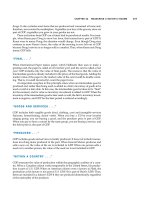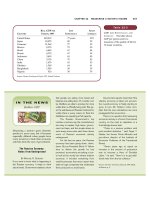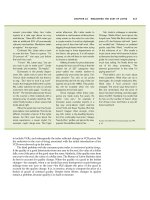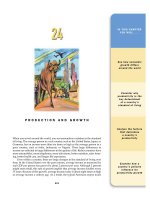Principles of conflict economics
Bạn đang xem bản rút gọn của tài liệu. Xem và tải ngay bản đầy đủ của tài liệu tại đây (1.76 MB, 345 trang )
This page intentionally left blank
PRINCIPLES OF CONFLICT ECONOMICS
Conflict economics contributes to an understanding of violent conflict in two
important ways. First, it applies economic analysis to diverse conflict activities
such as war, arms races, and terrorism, showing how they can be understood as
purposeful choices responsive to underlying incentives. Second, it treats
appropriation as a fundamental economic activity, joining production and
exchange as a means of wealth acquisition. Drawing on a half-century of
scholarship, this book presents a primer on the key themes and principles of
conflict economics. Although much work in the field is abstract, the book is
made accessible to a broad audience of scholars, students, and policy makers by
relying on historical data, relatively simple graphs, and intuitive narratives. In
exploring the interdependence of economics and conflict, the book presents in
novel ways current perspectives on conflict economics and offers new insights
into the economic aspects of violence.
Charles H. Anderton is Professor of Economics at the College of the Holy
Cross, Worcester, Massachusetts, where he has taught since 1986. He coedited
the volume Economics of Arms Reduction and the Peace Process with Walter
Isard in 1992. A former North American editor of the journal Defence and
Peace Economics, Professor Anderton’s research has appeared in journals such
as Economic Inquiry, Journal of Economic Behavior and Organization, Journal
of Conflict Resolution, Conflict Management and Peace Science, and Peace
Economics, Peace Science, and Public Policy, as well as in the Handbook of
Defense Economics, volumes 1 and 2.
John R. Carter is Professor of Economics at the College of the Holy Cross,
Worcester, Massachusetts, where he has served on the faculty since 1976. A
former Chair of the Department of Economics, Professor Carter received the
Holy Cross Distinguished Teaching Award in 1992. His research has appeared
in journals such as the Review of Economics and Statistics, Journal of Law and
Economics, Journal of Economic Perspectives, Journal of Economic Behavior and
Organization, Defence and Peace Economics, Journal of Peace Research, and
Public Choice, as well as in the Handbook of Defense Economics, volume 2.
Principles of Conflict Economics
A Primer for Social Scientists
CHARLES H. ANDERTON
College of the Holy Cross
JOHN R. CARTER
College of the Holy Cross
CAMBRIDGE UNIVERSITY PRESS
Cambridge, New York, Melbourne, Madrid, Cape Town, Singapore, São Paulo
Cambridge University Press
The Edinburgh Building, Cambridge CB2 8RU, UK
Published in the United States of America by Cambridge University Press, New York
www.cambridge.org
Information on this title: www.cambridge.org/9780521875578
© Charles H. Anderton and John R. Carter 2009
This publication is in copyright. Subject to statutory exception and to the
provision of relevant collective licensing agreements, no reproduction of any part
may take place without the written permission of Cambridge University Press.
First published in print format 2009
ISBN-13
978-0-511-50717-5
eBook (EBL)
ISBN-13
978-0-521-87557-8
hardback
ISBN-13
978-0-521-69865-8
paperback
Cambridge University Press has no responsibility for the persistence or accuracy
of urls for external or third-party internet websites referred to in this publication,
and does not guarantee that any content on such websites is, or will remain,
accurate or appropriate.
To Our Families
Contents
List of Figures
page xi
List of Tables
xvii
Preface
xix
1
2
3
4
Introduction: Definition and Scope of Conflict
Economics
1.1. What Is Conflict Economics?
1.2. A Look at Conflict Large and Small
1.3. Methodology of Conflict Economics
1.4. Organization of Book
1.5. Bibliographic Notes
1
1
2
10
13
13
Production Possibilities and the Guns versus Butter
Trade-Off
2.1. Production Possibilities Model
2.2. Applications
2.3. Bibliographic Notes
15
15
21
27
Rational Choice and Equilibrium
3.1. Rational Choice Model
3.2. Supply, Demand, and Market
Equilibrium
3.3. A Taxonomy of Goods
3.4. Bibliographic Notes
28
28
Fundamentals of Game Theory
4.1. Basic Concepts
4.2. Chicken and Prisoner’s Dilemma Games
4.3. Repeated Prisoner’s Dilemma
4.4. Bibliographic Notes
53
53
59
63
66
vii
43
50
52
viii
Contents
5
A Bargaining Model of Conflict
5.1. Elements of Conflict
5.2. Sources of Violent Conflict
5.3. Third-Party Intervention
5.4. Bibliographic Notes
67
67
69
78
81
6
Conflict between States
6.1. The Conflict Cycle
6.2. Patterns of Armed Interstate Conflict
6.3. Hirshleifer’s Bargaining Model and
Interstate War
6.4. Selected Empirical Studies of Interstate Conflict
6.5. Bibliographic Notes
83
83
85
7
87
92
101
Civil War and Genocide
7.1. Definitions
7.2. Patterns of Armed Civil Conflict and Genocide
7.3. Theoretical Perspectives on Civil War
7.4. Selected Empirical Studies of Civil War and
Genocide
7.5. Bibliographic Notes
104
104
105
113
8
Terrorism
8.1. Defining Terrorism
8.2. Patterns of Terrorism
8.3. A Rational Choice Model of Terrorism
8.4. Game Theoretic Perspectives of Terrorism
8.5. Selected Empirical Studies of Terrorism
8.6. Bibliographic Notes
126
126
127
132
139
146
153
9
Geography and Technology of Conflict
9.1. Boulding’s Model of Spatial Conflict
9.2. O’Sullivan’s Three-Dimensional Model of Spatial
Conflict
9.3. Schelling’s Inherent Propensity toward Peace or War
9.4. Number and Size of Nations
9.5. Selected Empirical Studies
9.6. Bibliographic Notes
155
155
10
Arms Rivalry, Proliferation, and Arms Control
10.1. Definitions
10.2. Patterns of Arms Rivalry, Proliferation, and
Arms Control
118
124
164
168
174
179
183
185
185
186
Contents
ix
10.3. The Richardson Arms Race Model
10.4. The Intriligator-Brito Model
10.5. An Economic Choice Model of Arms
Rivalry
10.6. Selected Empirical Studies
10.7. Bibliographic Notes
210
217
220
11
Military Alliances
11.1. Definitions
11.2. Patterns of Interstate Alliances
11.3. Pure Public Good Model of Alliances
11.4. Joint Product Model of Alliances
11.5. Selected Empirical Studies
11.6. Bibliographic Notes
222
223
226
229
237
240
244
12
Conflict Success Functions and the Theory of
Appropriation Possibilities
12.1. Conflict Success Functions
12.2. A Model of Appropriation Possibilities
12.3. Appropriation Possibilities in a Production/
Exchange Economy
12.4. Bibliographic Notes
Appendix A: Statistical Methods
A.1.
A.2.
A.3.
A.4.
A.5.
Populations and Samples
Probability and Sampling
Expected Values and Unbiased Estimators
Statistical Inference
Regression Analysis
Appendix B: A More Formal Bargaining Model of Conflict
B.1. Basic Model of Resource Conflict
B.2. Selected Sources of Violence
197
202
246
246
249
256
267
269
269
270
272
272
274
277
277
280
References
285
Author Index
307
Subject Index
315
Figures
1.1.
1.2.
1.3.
1.4.
1.5.
1.6.
1.7.
1.8.
2.1.
2.2.
2.3.
2.4.
3.1.
3.2.
3.3.
3.4.
3.5.
3.6.
3.7.
3.8.
War onsets per decade by war type, 1820–2006.
International and domestic terrorist incidents
combined, 1970–2004.
Real military spending in selected nations.
Destruction of human and physical assets during
World War II.
United States’ real merchandise trade with Germany
and Japan.
Annual cost of selected multilateral peace missions,
reporting year 2007.
Real expenditures on defense against crime and lost
value from property crimes.
Worldwide pirate attacks against merchant ships,
1998–2007.
Production possibilities frontier.
Specialized production and trade.
Economic diversion, destruction, and disruption
from violent conflict.
Channels by which defense spending can impact
economic growth.
Indifference curves for two goods.
Comparatively steeper indifference curves.
Consumption optimum.
Income response and income-consumption curve.
Price response and price-consumption curve.
Individual demand curve.
Income and substitution effects.
Fungibility of foreign aid.
xi
page 3
4
5
6
7
8
9
9
18
20
22
23
29
32
33
35
36
37
38
40
xii
3.9.
3.10.
3.11.
3.12.
3.13.
4.1.
4.2.
4.3.
4.4.
4.5.
4.6.
4.7.
4.8.
5.1.
5.2.
5.3.
5.4.
5.5.
5.6.
5.7.
5.8.
5.9.
List of figures
Land mines and the substitution principle.
Market supply, demand, and equilibrium.
Market response to an increase in supply.
Small arms control.
Trade and the liberal peace hypothesis.
Aggression game shown in extensive form.
Aggression game shown in normal form.
Aggression game with Nash equilibriums.
Aggression game solved by backward induction.
Chicken game with simultaneous moves.
Chicken game with sequential moves.
Prisoner’s dilemma game with simultaneous moves.
Stage game for repeated prisoner’s dilemma game.
Bargaining model with peaceful settlement.
Inconsistent expectations with fighting.
Two-player commitment problem.
Commitment problem and indivisibilities.
Commitment problem and preemptive war.
Commitment problem and preventive war.
Malevolent preferences with fighting.
Malevolent preferences with peaceful settlement.
Possible fighting when player B is subject to
political bias.
5.10. Third-party economic intervention.
5.11. Third-party mediation or military intervention.
5.12. Third-party intervention favoring player A.
6.1. Lund’s conflict life cycle.
6.2. Selected interstate conflict datasets.
6.3. MID Onsets, MIDs-Use-Force, and MIDs-to-War,
1816–2000.
6.4. Bargaining model with complete information and
no commitment problems.
6.5. Bargaining model with incomplete information and
increased cost of war.
6.6. Diversion, destruction, and disruption costs of
World War I.
7.1. Selected intrastate conflict datasets.
7.2. Stock of armed civil conflicts, 1946–2006.
7.3. Armed civil conflict onsets, terminations, and durations,
1940s–2000s.
42
43
46
47
48
54
55
57
59
60
61
63
64
68
70
71
72
73
74
75
76
77
79
80
80
84
85
88
90
91
101
106
108
108
List of figures
7.4.
7.5.
7.6.
7.7.
7.8.
8.1.
8.2.
8.3.
8.4.
8.5.
8.6.
8.7.
8.8.
8.9.
8.10.
9.1.
9.2.
9.3.
9.4.
9.5.
9.6.
9.7.
9.8.
9.9.
9.10.
9.11.
9.12.
10.1.
10.2.
Stock of armed civil conflicts by region, 1975–2005.
Range of battle-related deaths from armed civil
conflicts, 1946–2005.
Number of refugees and internally displaced persons
for selected countries of origin, provisional data, end
of year 2007.
Estimated fatalities for selected genocides and
politicides, 1965–2006.
Net revenue model of rebellion.
Terrorism incidents worldwide.
Casualties per incident from terrorism, 1970–2004.
Terrorism by region, 1970–2004.
Terrorists’ modes of attack, 1970–2004.
Terrorists’ optimal choice of terrorist activity
and composite good.
Changes in terrorists’ budget constraint.
Deterrence and benevolence price policies.
Hostage game.
Offensive counterterrorism games between governments.
Supply and demand of suicide bombers.
Boulding’s basic model of spatial conflict.
Conditional viability of player B.
Protection of Tutsis in soccer stadiums during
1994 Rwandan genocide.
Offensive technological innovation by player A.
Installation of a military base.
Effect of a buffer zone.
Strategic depth.
Pyramid model of spatial distribution of military
power.
Rebel concentration of military power and conquest
of the state.
Lanchester attack/defend model.
Number of states in the international system,
1820–2004.
Determination of the number and average size
of nations.
World real military spending, 1988–2007.
Real military-spending patterns in selected
interstate arms rivalries.
xiii
109
110
111
112
117
129
130
131
132
133
134
136
140
144
149
156
157
159
160
161
162
163
165
167
171
174
176
187
188
xiv
List of figures
10.3. Number of states suspected of nuclear weapons
research and possession.
10.4. Richardson arms race model.
10.5. Intriligator-Brito model.
10.6. Iranian nuclear weapons proliferation in the
Intriligator-Brito model.
10.7. One-sided antiballistic missile defense in the
Intriligator-Brito model.
10.8. Inherent propensity toward war with high attack
effectiveness.
10.9. Player A’s optimal allocation of resources to civilian
and military goods.
10.10. Arms rivalry equilibrium in the economic choice
model.
10.11. Effect of economic growth in A on arms rivalry
equilibrium.
10.12. Arms control in the economic choice model.
11.1. Number of interstate alliances as reported by ATOP
and COW.
11.2. Number of interstate alliances with pledges of
active military support.
11.3. Number of multilateral alliances.
11.4. Alliance commitments of the major powers in 2003.
11.5. Ally A’s optimal allocation of resources to civilian
and military goods.
11.6. Reaction functions and alliance equilibrium.
11.7. Free riding by ally B.
11.8. Alliance suboptimality.
11.9. Disproportionate burden for wealthier ally B.
11.10. Reaction functions for a pure versus impure
public good.
12.1. Ratio form conflict success functions for player A.
12.2. Logistic form conflict success functions for player A.
12.3. A’s optimal allocation of resources to military goods.
12.4. Resource conflict in Hirshleifer’s bargaining model.
12.5. Optimal production and consumption in autarky.
12.6. Gains from exchange in an Edgeworth box.
12.7. Gains from specialized production and exchange.
12.8. Effects of diversion of resources to military goods.
12.9. Effects of destruction and trade disruption.
191
201
204
206
207
209
211
212
213
215
226
227
228
228
230
232
233
234
236
239
247
248
250
255
257
258
259
261
262
List of figures
12.10. Predator/prey game.
12.11. Equilibrium economies in the predator/prey game.
A.1. Probability distribution of sample proportion
P when p ¼ 0.50 and sample size is four.
xv
264
265
271
Tables
1.1.
2.1.
3.1.
3.2.
6.1.
8.1.
8.2.
10.1.
10.2.
10.3.
10.4.
10.5.
11.1.
11.2.
12.1.
A.1.
A.2.
Victims of human trafficking worldwide.
Economic and military data for North Korea,
South Korea, and the United States, 2007.
Utilities assigned by the function U ¼ xy.
Taxonomy of goods with examples.
Interstate war duration, severity, and intensity,
1816–2006.
Selected terrorism datasets.
International terrorist hijackings, 1968–1977.
Estimated effects of large-scale weapons of mass
destruction attacks.
Proliferation of weapons of mass destruction for
selected nations, 2007.
Selected US-Russia (USSR) arms control treaties.
Selected nonproliferation treaties and programs.
Selected SALW control organizations and protocols.
Selected military alliances.
Burden sharing in NATO, 1964 and 1971.
Numerical example of resource conflict model.
Possible samples and the corresponding proportions
answering Yes.
Regression results for military spending as a function
of democracy and income.
xvii
page 10
25
31
50
89
128
138
191
193
194
196
198
224
241
253
271
275
Preface
Now the earth was corrupt in God’s sight and was full of violence.
Genesis 6:11
Throughout recorded history, violent conflict has been a conspicuous aspect
of the human experience. In recent decades, terrorism, civil strife, nationstate warfare, and the proliferation of weapons of mass destruction have
dominated the headlines. It might at first appear that economics has little to
say about such realms of conflict. After all, most economics textbooks restrict
their attention to the behavior of consumers, producers, and governments
operating peacefully in secure environments. Fortunately, however, the
rapidly developing field of conflict economics can contribute greatly to an
understanding of conflict in two important ways. First, conflict economics
rigorously applies the concepts, principles, and methods of economics to the
study of diverse conflict activities. Second, conflict economics treats
appropriation as a fundamental economic activity, revealing how conflict
both shapes and is shaped by the traditional economic activities of
production and trade.
This book provides the reader with an accessible overview of the basic
principles and major themes of conflict economics. Following an introduction to the field in Chapter 1, Chapters 2 through 4 survey many of the
economic concepts and methods applied in subsequent chapters. These
chapters will be useful to readers who either have no formal training in
economics or would like to review economic principles with a focus on
conflict. Chapters 5 through 11 explore major topics in conflict economics,
including the bargaining theory of war; conflict between states; civil war and
genocide; terrorism; the geography and technology of conflict; arms rivalry,
proliferation, and arms control; and alliance behavior. These chapters provide
a balanced mix of theoretical and empirical content. Chapter 12 is more
xix
xx
Preface
theoretical and treats appropriation as a fundamental economic activity,
joining production and trade as a means of wealth acquisition. Bibliographic
notes are provided at the ends of chapters to help readers who want to pursue
topics in greater depth. Two appendixes are also available – a primer on
statistical analysis and a bargaining model of conflict.
Given our training and background, we concentrate on economic aspects of
conflict. Although we recognize and incorporate contributions from various
disciplines, especially political science, we defer to specialists in other fields to
convey those contributions more thoroughly. Our emphasis on economic
aspects of conflict can be valuable to both economists and non-economists. For
economists, the book shows numerous ways in which economic methods can
be applied to conflict issues. Moreover, the book’s treatment of conflict as a
fundamental category of economic activity will help economists reduce the gap
that now exists between textbook models of peaceful production and exchange
and real economies subject to potential or actual violence. The book should
also appeal to those with backgrounds in fields other than economics. Noneconomists are naturally drawn to incorporate economic variables in their
studies of conflict, and our book offers coverage of such variables from the
perspective of the economist. Also, many models and methods central to
conflict economics (e.g., rational choice theory, game theory, and econometrics) are of growing importance in disciplines other than economics.
Much of the academic work in conflict economics is theoretical and
abstract, but we take steps to increase the accessibility of the text. In addition
to the overview of economic fundamentals in Chapters 2 through 4, the book
contains extensive coverage of conflict data, intuitive narratives, relatively
simple algebra and graphs, and summaries of empirical evidence on conflict
phenomena. Furthermore, the book is organized so that the more accessible
chapters occur early and the more difficult chapters later. The book should be
useful to scholars, policy makers, and practitioners from a variety of
disciplines and backgrounds, including economics, political science, international relations, peace studies, military sciences, and public policy. It should
likewise be suitable in undergraduate or beginning-level graduate courses on
the economics of conflict and in courses on war and peace at universities and
military service schools.
The social science literature on conflict is massive. Hence, we are selective
in the topics covered, theories emphasized, empirical articles reviewed, and
bibliographic notes provided. The particular empirical articles that we choose
to review are selected because they are relatively recent and highlight the
importance of economic variables in conflict analysis. Thus, we do not
necessarily choose seminal empirical studies for review, nor do our
Preface
xxi
summaries of results necessarily reflect ongoing empirical controversies
within topic areas. Finally, although the book covers issues pertinent to many
contemporary conflicts such as those in Iraq, Afghanistan, and Sudan-Darfur,
we do not attempt to focus the book on current events and policy debates.
Instead, our goal is to emphasize principles of conflict economics that will be
as useful in exploring conflicts yet to emerge as they are in studying historical
and contemporary events.
Over the years, many scholars have shaped our thinking about conflict
economics and encouraged our attempts to contribute to the field. We regret
that we can mention only a few, but they include Jurgen Brauer, Keith
Hartley, Jack Hirshleifer, Michael Intriligator, Walter Isard, and Todd
Sandler. We also wish to acknowledge our former students, especially those in
Experimental Microeconomics and Economics of Peace, Conflict, and
Defense, both upper-level courses taught in the Department of Economics
at the College of the Holy Cross. Their questions and comments have
contributed greatly to our understanding of pedagogy in general and conflict
economics in particular.
We are indebted to Scott Parris at Cambridge University Press for
encouragement and advice over the course of the project; to the production
staff at Cambridge University Press for their excellent work; to Daniel Arce,
Jurgen Brauer, and several anonymous reviewers for extensive and insightful
comments on various drafts; to Roxane Anderton for help with citations; to
Erin Wall (College of the Holy Cross, 2006) for research assistance funded by
the May and Stanley Smith Charitable Trust Summer Research Assistant
Program; to the College of the Holy Cross for timely research leaves; and to
Nancy Baldiga, Miles Cahill, Robert Frank, George Kosicki, and Todd Sandler
for generous letters of support. We are especially grateful to our wives,
Roxane Anderton and Gloria Carter, for their love and understanding,
without which this book would not have been possible.
1
Introduction: Definition and Scope of Conflict Economics
For many people, in many places, violent or potentially violent conflict is
part of the human experience. Headline stories of civil strife, insurgency,
nation-state warfare, terrorism, and the proliferation of weapons of mass
destruction document the prevalence of conflict as a basic fact of life. Less
dramatic indications of conflict include deadbolt locks, gated residential
communities, electronic security systems, and handgun sales, to name a
few. At first blush, it might appear that economics has little if anything to
say about life’s harder side. Economics textbooks typically restrict their
attention to the peaceful behavior of consumers, producers, and governments in the marketplace. Thus, it might seem that potential and actual
violence over resources, goods, and political power lie outside the domain
of economics. But this is a misperception, as is demonstrated by the
rapidly developing field of conflict economics.
1.1. What Is Conflict Economics?
Conflict economics has two defining characteristics. First, it maintains that
the concepts, principles, and methods of economics can be fruitfully
applied to the study of conflict activities. Thus, diverse phenomena like
war, arms races, alliances, and terrorism are analyzed and understood as
outcomes of purposeful choices responsive to changes in underlying
incentives. As just one example, economics explains how consumers shift
purchases from one good (say orange juice) toward another (say grape
juice) when the price of one rises relative to that of the other. Similar
economic forces are at work in many conflict settings: when one type of
weapon is constrained by arms control, another type is substituted; when
political targets are hardened, terrorists turn to less costly civilian targets;
1









